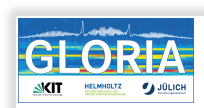|
Scientific Partners
- Forschungszentrum Jülich (Prof. Martin Riese)
- Karlsruhe Institute of Technology
(Prof. Johannes Orphal)
- GFZ German Research Centre for Geosciences
(Prof. Jens Wickert)
- MPI Meteorologie Hamburg (Prof. Bjorn Stevens)
- MPI Chemie Mainz (Prof. Stefan Borrmann)
- DLR Institut für Physik der Atmosphäre
(Prof. Markus Rapp)
- GEOMAR Helmholtz Zentrum für Ozeanforschung Kiel
(Prof. Katja Matthes)
- AWI Alfred Wegener Institut Bremerhaven
(Prof. Thomas Jung)
- Leibniz-Institut für Atmosphärenphysik Kühlungsborn
(Prof. Franz-Josef Lübken)
- Freie Universität Berlin (Prof. Ulrike Langematz)
- Universität Bremen (Prof. John Burrows)
- Goethe Universität Frankfurt (Prof. Ulrich Achatz)
- Ernst Moritz Arndt Universität Greifswald
(Prof. Christian von Savigny)
- Ruprecht-Karls-Universität Heidelberg
(Prof. Klaus Pfeilsticker)
- Universität Leipzig (Prof. Christoph Jacobi)
- Johannes Gutenberg-Universität Mainz
(Prof. Peter Hoor)
- Bergische Universität Wuppertal (Prof. Ralf Koppmann)
|
Support by international organisations
- World Meteorological Organization (WMO)
- World Weather Research Programme (WWRF)
- Global Atmospheric Watch (GAW)
- World Climate Research Programme (WCRP)
- Stratosphere-troposphere Processes And their
Role in Climate (SPARC)
- International Geosphere-Biosphere Programme (IGBP)
- International Global Atmospheric Chemistry (IGAC)
- Scientific Committee on Solar-Terrestrial Physics (SCOSTEP)
- Variability of the Sun and Its Terrestrial Impact (VarSITI)
Support by weather services
- European Centre for Medium-Range Weather Forecast (ECMWF)
- Copernicus Atmospheric Monitoring Service (CAMS)
- Deutscher Wetterdienst (DWD)
- Royal Netherlands Meteorological Institute (KNMI)
- Finnish Meteorological Institute (FMI)
|
The expected user group encompasses the entire community of atmospheric and climate sciences worldwide as well as the national and international weather services. The majority of users (approx. 80 %) comes from the scientific sector and is organized in international programmes and institutions (e. g. World Climate Research Programme (WCRP), International Geosphere-Biosphere Programme (IGBP), and the World Meteorological Organization (WMO)). Other users come from the area of data assimilation (e. g. Global Climate Observing System (GCOS) and the Copernicus Atmosphere Monitoring Service (CAMS)).
The quantification of the influences of changes in the middle atmosphere on the surface climate necessitates an integrated utilization of observational data, process-oriented simulations, and Earth system and climate modelling. A reduction of the uncertainties in model projections requires a data base with improved three-dimensional resolution as provided by AtmoSat. A scientific steering committee will be set up to integrate the scientific partners into the development of the project. It will comprise one representative from each of the responsible institutions and the scientific partners listed in the concept. Moreover, three further governance instruments will be established: First, an assembly of core partners, second, a board of directors, and third a scientific advisory board.

